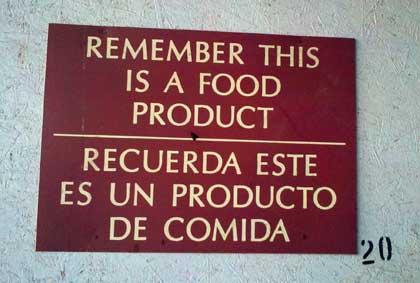
This sign hangs (on several walls) at the Segal Hop Ranch in Grandview, Washington (Yakima Valley).

This sign hangs (on several walls) at the Segal Hop Ranch in Grandview, Washington (Yakima Valley).
Notice a trend here?
In 1911, exactly one hundred years ago, world consumption of hops was 0.63 pounds per hectoliter (0.54 per barrel), amounting to 12.6 grams of alpha per hectoliter.
The best comparison going forward is grams of alpha per hectoliter, rather than bulk, because of the advent of high alpha hops and the use of pellets and extracts.
In the early 1970s — when about one-third of hops were processed, compared to nearly 90 percent today — the rate was 9 grams per hectoliter.
Here’s how it has progressed since:
1979 – 8 grams
1989 – 7 grams
1997 – 6 grams
2011 – 4.1 grams
Source: Barth Report, from the Barth Haas Group
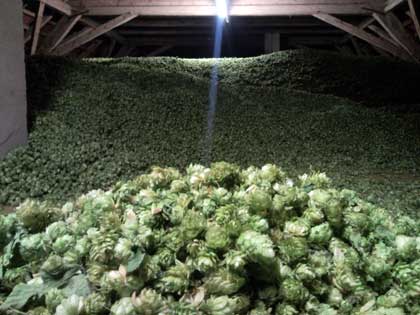
These hops will be headed from Germany to St. Louis soon enough, although not in this form. More about that below.
Last month Tony Redsell, who is now in the midst of his 63rd hop harvest, interrupted our conversation to answer a phone call. He patiently and quickly explained the basics of hop harvest, both past and present. “We’re coming to the silly season,” he explained after he hung up. “Every editor thinks, let’s have an article on hops. ‘Hopping down in Kent.'”
Redsell is one of England’s best and best known hop farmers, although hops cover just 200 of the 3,000 acres that make up his various farms in Kent, southeast of London. “I’m not known internationally for my cherries,” he said, laughing. He might have added they are consider some of the best in Kent, also known at “The Garden of England.”
Not everybody agrees how romantic it was for Londoners to “hop on down to Kent” each year to live in huts and pick hops until their hands were black with resin. But it makes a nice story and hops are a great visual, including video.
It makes me realize “Romancing the Hop” might make an even better title for a book than “For the Love of Hops.” My Twitter feed is littered with news about harvest (or “fresh hop” or “wet hop”) beers right now – like this. And the stories aren’t just out of traditional hop growing areas. Jeff Alworth did a nice job of summarizing several yesterday. Throw San Diego to the mix, then consider Jeff’s conclusions.
It’s great fun and exciting. Those hops at the top will be pelletized before they are shipped to St. Louis, but freshly cut (thus “wet”) hops will soon by on the way from Yakima. Next week brewers in several small St. Louis brewers will toss them into kettles, producing beers for the Fresh Hop Beer Festival Oct. 22 at Schlafly Bottleworks in Maplewood.
Just to be clear, I marked the date on our calendar more than two months ago. We plan to be there, but I’m just as excited about finding out what the Urban Chestnut Brewing beers made with Hallertau Mittelfrüh hops from the Seitz farm outside of Wolnzach taste like.
Before winemakers co-opted the word terroir it meant something more general. Grand dictionnaire universel du XIXe siècle, Pierre Larousse’s nineteenth-century French dictionary, defines terroir as “the earth considered from the point of view of agriculture.” It describes le goût de terroir as “the flavor or odor of certain locales that are given to its products, particularly with wine.”
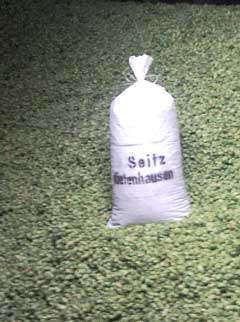 Not a month ago Florian Seitz led me up hills and under hop trellises on his family’s farm. His great grandfather first planted hops on it in 1869, and it was a farm even before that. As well as hops they grow corn, wheat and other cash crops, and trees (some become chips, others wood for logs). Florian took over the farm in 2008, but his father still walks the fields regularly and takes charge of drying the hops during harvest.
Not a month ago Florian Seitz led me up hills and under hop trellises on his family’s farm. His great grandfather first planted hops on it in 1869, and it was a farm even before that. As well as hops they grow corn, wheat and other cash crops, and trees (some become chips, others wood for logs). Florian took over the farm in 2008, but his father still walks the fields regularly and takes charge of drying the hops during harvest.
I’d be a liar if I suggested that in a blind tasting I could say, “This Mittelfrüh came from land I walked on and that one didn’t.” (Heck, Redsell’s East Kent Goldings regularly medal in the Annual Hop Awards and he’ll admit he can’t always tell the difference between his Goldings and those of a neighbor.) But to me it makes a difference that I walked through the hop yards and that the wood beams in the drying barn were hand-crafted in 1904.
I first met Seitz last March in St. Louis. Representatives of the association of German Hop Growers visited Urban Chestnut Brewing after attending the Craft Brewers Conference in San Francisco, Seitz included. It was a good excuse for UCB to throw its first festival, called Hopfenfest. At the time, UCB co-founder and brewer Florian Kuplent contracted to buy Mittelfrüh from Seitz.
Most of those will arrive as pellets, but Seitz is also be shipping a relatively small bale of cones (second photo). “As a grower you are proud when you see what happens with your hops, when the product made from your product is good,” Seitz said.
“For the brewers it is good to see where your products are grown,” he said.
Likewise for us drinkers.
————
Thanks to Florian Seitz for sending the fresh photos.

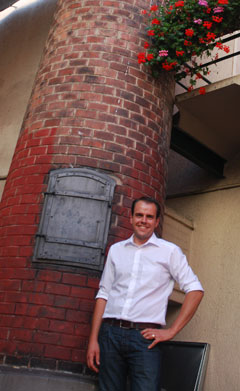 The guest rooms at Brauerei und Gasthof zur Krone in Tettnang in the southwest of Germany are thoroughly modern, with hardwood floors, whitewashed walls and sleek amenities; yet properly spare. The building, on the other hand, has been around since before the last Montfort, Count Anton IV, lived here in the 18th century.
The guest rooms at Brauerei und Gasthof zur Krone in Tettnang in the southwest of Germany are thoroughly modern, with hardwood floors, whitewashed walls and sleek amenities; yet properly spare. The building, on the other hand, has been around since before the last Montfort, Count Anton IV, lived here in the 18th century.
The Tauscher family bought the brewery, which sits directly behind the hotel, in 1847 and Fritz Tauscher (right) is a seventh generation brewer. The Kronen-Brauerei is the last of 26 breweries that used to operate in Tettnang. It produces about 6,000 hectoliters (something more than 5,000 barrels) a year, about 60 percent of that sold in bottles labeled “Tettnanger.”
Tauscher is one of nine brewers in a group they call “Brauer mit Leib and Seele” (Brewers with body and soul). “All are owners of breweries in the hands of the their families,” he explained. “The beers are brewed with our hands.”
Tradition obviously matters, but Tauscher talks as much about the importance of quality. He buys his hops directly from two nearby farms, one organic and the other not. He uses only cones, storing the bales in one of four lagering rooms eight to nine meters below the brewery yard. He begins fermentation of his lagers between 8° C and 9° C (other breweries might start higher to speed the process). He lagers his beers for six to eight weeks (Berliner Kindl Pils lagers for two weeks). He uses less efficient (smaller and horizontal) tanks because he can taste the difference.
Tauscher attended the Craft Brewers Conference in San Francisco last spring. He drank plenty of new wave American beers, packed with alcohol and aromatic hops. He’s not just being polite when he talks about how much he enjoyed them.
“I can imagine I will brew one or two beers with those (sort of) hops,” said Tauscher, who is 31 years old. “But not yet. The German beer drinkers are not ready for the explosion of flavors.”
Tauscher adds only Tettnang Tettnanger hops to the beers he sells (he recently brewed a special batch for hop growers that included four additions of Tettnanger and then Saphir at the finish). Tettanger has served perfectly well for special celebration beers, such as for Tettnang’s 700th anniversary party and the brewery’s 150th anniversary (a “fresh hop” beer in 1997).
When Tauscher does begin using other varieties they will still be from Tettnang. Tettnang farmers also grow Hallertau Mittelfrüh and Tradition, Perle, Saphir and Herkules, and there will be others. One might well be a variation on Tettnanger. The German hop research center at Hüll this year began a project in partnership with the Tettnang Hop Growers Association and Baden-Württemberg Ministry of Rural Development to breed a new variety with Tettnang Tettnanger as the mother. If a new hop results it will still be 10 years before it’s ready for brewers to use.
At Brauerei und Gasthof zur Krone that doesn’t seem like such a long time. It sits in the center of town, on a square that will be overflowing for a band concert on a Wednesday evening in summer. Although the town may be best known for hops its population is growing because of high tech businesses and tourism. Old world and new world coexist comfortably.
The hotel serves tourists and business travelers equally well. Each room has its own name — thus Bierbrauer, Bärenpltaz and Brau Wasser as well as Hopfen — decorated to that theme.
You can probably guess which one I stayed in.
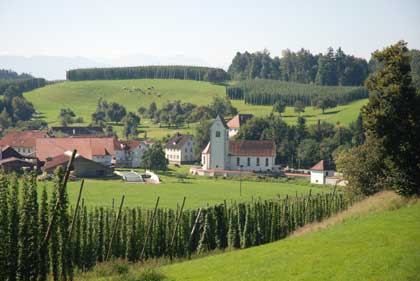
The Tettnang hop growing in the southwest of Germany. (And the photo that has replaced one taken along the Beartooth Highway leading into Yellowstone as my desktop background.)
More next week, but if you’re of a mood to consider terroir Zac Early has a “new, looser interpretation” (music included).